Punkinhed7
Member
- Joined
- Apr 5, 2011
- Messages
- 222
- Format
- Multi Format
I picked up this lens recently and am having a bit of trouble digging up any information on it. I realize that this technically may not be the correct forum to ask about this particular lens but I figured the LF users might have a bit more experience trying to use unusual old lenses so I was hoping that someone here might be able to help shed some light. Please forgive me for the hasty iphone snaps.
The lens itself measures approximately 8 inches long with a diameter of ~ 4 inches. The rear element/housing is ~3/4" diameter.
Given that it is marked USAF (and the wide FOV) I assumed it may have been used in some aerial application but if I'm way off base, please let me know. Google searches haven't yielded much information and the only reference to something similar that I've been able to find was for a 142 degree projection lens that was used in artillery/arms training.
I was unable to get it to focus on my Cambo SC through the entire range of extension -- minimum using bag bellows.
Assuming the ' EFL : 0.147" ' indicates effective focal length (3.7338mm) I used the AFOV formula: to calculate the horizontal dimension of the intended film format and came up with 21.687mm, which seems like a mighty small image circle for such a beast of a lens. If I've misapplied this formula, used the wrong value for AFOV, etc. please correct me. This was the actual calculation:
to calculate the horizontal dimension of the intended film format and came up with 21.687mm, which seems like a mighty small image circle for such a beast of a lens. If I've misapplied this formula, used the wrong value for AFOV, etc. please correct me. This was the actual calculation: 
As for the notation: ' FD: 1.102" ' is this an indication of focal distance...ie. the lens should be 1.102" from the film plane for focusing? If so, that might explain my trouble so far in getting it to focus.
Also, marked aperture click stops are 1.5, 2, 2.8, 4, 5.6, 8, 11, 16
Anyways, I appreciate any and all comments y'all might have as to the origins, intended use and, most of all, possible future uses for this creature.
Thanks in advance
Photos of the lens:
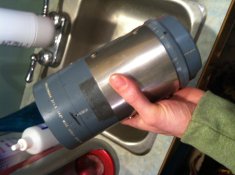
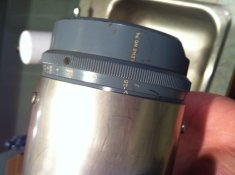
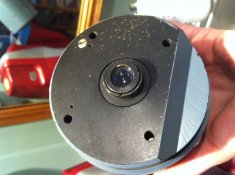
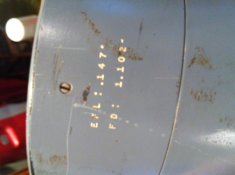
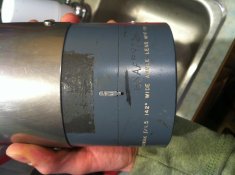
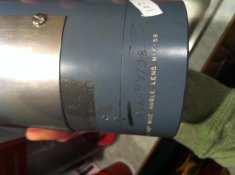
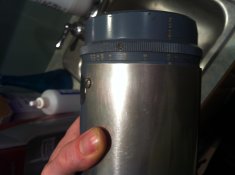
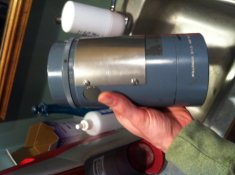
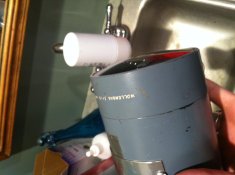
The lens itself measures approximately 8 inches long with a diameter of ~ 4 inches. The rear element/housing is ~3/4" diameter.
Given that it is marked USAF (and the wide FOV) I assumed it may have been used in some aerial application but if I'm way off base, please let me know. Google searches haven't yielded much information and the only reference to something similar that I've been able to find was for a 142 degree projection lens that was used in artillery/arms training.
I was unable to get it to focus on my Cambo SC through the entire range of extension -- minimum using bag bellows.
Assuming the ' EFL : 0.147" ' indicates effective focal length (3.7338mm) I used the AFOV formula:

As for the notation: ' FD: 1.102" ' is this an indication of focal distance...ie. the lens should be 1.102" from the film plane for focusing? If so, that might explain my trouble so far in getting it to focus.
Also, marked aperture click stops are 1.5, 2, 2.8, 4, 5.6, 8, 11, 16
Anyways, I appreciate any and all comments y'all might have as to the origins, intended use and, most of all, possible future uses for this creature.
Thanks in advance
Photos of the lens:









Last edited by a moderator:


